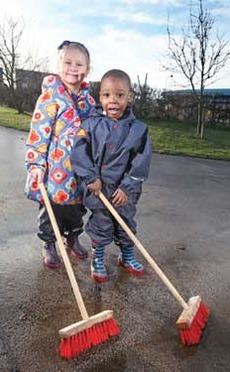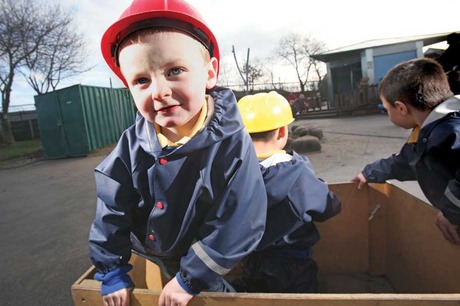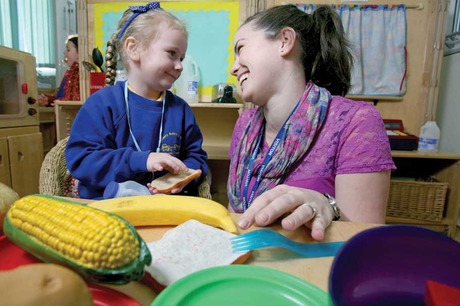
All of us here are privileged to be working with children at the start of their lives. Beginnings are always exciting - there is everything to play for and always uncertainties, notably in regard to children's potential. We may be sure of what our children achieve today, but we can never be sure of what they may achieve tomorrow.
We have come a long way in early years and our huge workforce has benefited from considerable professional development. This must be recognised. But now, in today's complex and fast-moving society, we face some intricate issues.
THE CURRENT CLIMATE
Huge financial inequalities for young families
The gap between families living in comfortable circumstances and those in poverty is ever widening, and this impacts on children's life chances.
Those from poorer backgrounds do worse in terms of achievement and behaviour than those from more affluent homes. The Frank Field report stated that the poorest 20 per cent of children are more likely to show conduct problems at five years and show risky behaviour later in school. Schools don't appear to close the gap effectively and those who arrive in school as poor performers tend to stay there.
Making a difference
In the Government's mandate to make a difference to all children, practitioners are charged to reduce inequalities and focus particularly on those families in the greatest need and children who are at risk. Studies show that babies and children under three are in the weakest position and least able to defend themselves.
This is intensely demanding work because families with multiple problems tend to distrust those in authority and sometimes shy away from offers of support. The work takes time and infinite patience; it is best achieved through a first-class key person who works closely with parents and other agencies.
Young children's experiences of stress and trauma
Let's remember that a huge number of children fare well in life but equally, everywhere, every day, there are children who experience forms of stress or trauma. These can include:
Common stresses
Many young children:
- live with family members who are harassed through juggling the demands of work, home and childcare and have too little time to spend with their children
- encounter daily transitions to multiple caregivers as they move from home to a breakfast club to nursery education in the morning, childcare in the afternoon and are collected by a childminder before returning home. As young children are passed through these provisions, they often experience lack of continuity and lack the constant presence of their key person
- face unrealistic demands to achieve from some early years providers and ambitious and competitive parents.
Crises
All children may face a sudden and sometimes unexpected predicament or calamity in their life, such as:
- bereavement, where the child has to face the death of a person close to them and the consequences of living without that person
- family break-up, when one parent is absent from the home and is less available to the child
- a parent losing their job, sometimes resulting in severe financial difficulties and loss of the child's home.
Persistent stress and anxiety
Persistent stress and anxiety can occur when children live within troubled or fragile families. These families, for many reasons, find life difficult and where this is long term there is a danger that the family becomes dysfunctional.
Parents invariably want the best for their children, but sometimes their own circumstances prevent them from acting in the child's interests. In the worst instances, children are neglected or abused. The research report In the Eye of the Storm: Britain's forgotten children and families suggests that fragile or vulnerable families are defined as those with at least five out of the following indicators of vulnerability:
- worklessness
- poverty
- physical or mental disability or long-term illness
- poor-quality housing
- no qualifications
- maternal mental health problems
- criminality
- isolation due to ethnicity or citizen status
- abusive relationships involving both adults and children
- drug and alcohol dependency
- homelessness and ongoing temporary accommodation.
These factors can be used to identify groups of children who are likely to be vulnerable, but not all coming from these backgrounds will necessarily be at risk.
Worryingly, the study suggests that numbers of families experiencing these vulnerability factors are projected to increase. By 2015:
- the changes to the tax and benefits system combined with spending cuts mean that families with five or more vulnerabilities will lose around £3,000
- there will be 120,000 more families out of work
- 25,000 more families will have a mother suffering from mental depression
- 100,000 more families will be living on a low income (60 per cent below the average)
- 25,000 more families will live in material deprivation
- 40,000 more families will live in poor-quality or overcrowded accommodation.
All children are vulnerable to some extent, but the higher the number of ongoing stresses that any child faces, the harder they are likely to find it to cope.
A one-off negative experience such as the death of a close grandparent or parental separation will of course cause pain; nonetheless a healthy and well-loved child is likely to cope over time. But constant exposure to stress and anxiety resulting from the family factors above weakens a child's natural coping strategies and that child becomes vulnerable.
CASE STUDY
Three-year-old Carlos had parents who worked full time and he was cared for by his granny who lived with them. Carlos was deeply attached to his granny and was bereft when she suddenly died of a heart attack.
Carlos immediately started at the local nursery and the parents were faced with the cost of full-time childcare. Their rent increased as granny no longer lived with them and they were deemed to have accommodation additional to their needs. The parents were forced to move into a smaller, cramped flat to meet their increased financial commitments.
Carlos was bereaved, uprooted from his familiar home and suddenly faced with a transition to the nursery. Unsurprisingly, he found it very difficult to leave his mother and settle into the group. Each day he sat in the same position in the nursery room, gazing through the window and crying for his granny.
Emma, his key person, spent much of her time with him, initially just holding his hand. Maria, his mother, was very anxious about her son but was also depressed about her own circumstances, confiding in Emma that she was about to separate from her husband who had started to drink heavily.
Emma finally persuaded Carlos to draw a picture for his granny, which he could place as a present on her grave. At Emma's suggestion, the family visited the cemetery and Carlos placed his drawing on the grave and spoke to granny.
His parents held hands and smiled at one another. The following day, Carlos brought in a photograph of his granny and Emma helped him stick it on his cloakroom peg. He listened carefully when Emma read him the story of Badger's Parting Gifts.
Comment
Carlos has experienced several sudden crises in his life, but Emma's commitment to him and her creative way of helping him to come to terms with granny's death may have assisted the whole family.
HELPING VULNERABLE CHILDREN TO GROW STRONG

How do we best arm vulnerable children to help them withstand some of life's difficulties and grow strong? Central to this is fostering children's resilience.
Resilience is a wonderful term implying strength, resistance, flexibility and the ability to bounce back. These are universal qualities to instil in all young children, but they are essential for the most vulnerable. Children who are growing up in difficult circumstances particularly need to become resilient. There are various valuable ways to foster this essential life skill.
Provide for the 'pool of memory'
During the early years of life, children amass experiences and many of these experiences remain with them throughout life. We know only too well that some children encounter negative and distressing events that will continue to live with them: it is our critical task to balance that by providing rich, positive and nurturing experiences to add to their pool of memory, which they can draw on to sustain them throughout their lives (referred to by the Italian nurseries in Reggio Emilia as 'the extra pocket').
Our task
- Provide opportunities for child-chosen play, which as Vygotsky argued contains all the essential elements to feed a young child's development.
- Introduce interesting real-life authentic events that provoke children to explore and ask questions.
Ask yourself: what memories of your settings do you hope young children will take with them?
Support children to be social
Most young children are naturally friendly. This is a wonderful benefit, as having friends is regarded as a key factor in leading a happy life.
Evidence points to children who have a friend finding transition much easier. And friendships are, of course, particularly important if you are lonely and have not got a happy home life.
As children move into the later stages of the Early Years Foundation Stage, they spend a great deal of emotional energy thinking about friendships. Sadly, for some children friendships are elusive - due perhaps to them being dirty, or badly clothed or acting differently. Other children may shy away from them or withdraw from their overtures.
We should support children's social development at an early stage of their lives. A three- or four-year-old who finds it difficult to make friends can turn into a social isolate and possibly become a school refuser - for vulnerable children, this can only compound their difficulties.
Our task
- Ensure the child's attachment. If this attachment has not taken root at home, then it is all the more important that it is secure in your setting with the child's key person being a supportive and trusted friend.
- Place priority on developing and modelling a climate of kindness and consideration for others -helping all children to rub along with others.
- Help children who find friendships difficult to acquire the skills of friendship - sometimes we need to engineer friendships (give a new or friendless child a new friend), support a child to gain access to group activities or help children to cope with the trauma of losing a friend.
- Children do fall out but often given time they are able to solve their own altercations. Be wary of intervening too early.
Ask yourself: what alerts you to children's lack of social skills?

Provide challenge
Young children need more than a safe and benign environment. All of us thrive on a bit of challenge and at times to experience a little rush of adrenalin as we face physical and mental stimulation. These experiences fuel development and healthy young children thrive on them.
Vulnerable children - like their peers - need to experience success, to encounter risky freedom and to relish achievement that has followed from real effort. But this is often a slow process with individuals who may have learned that they are worthless and a nuisance.
So we should expect all our children to fly but always be there ready with a safety net: encouraging without overbearing control.
Our task
- Provide adventurous rather than nice safe experiences. Support independence. Let them climb a low-branched tree rather than a very predictable climbing frame, or use a hole puncher or stapler for themselves (having been taught to do so).
- Use risk assessments and understand that this does not mean wrapping children up in cotton wool.
- Provide for intrigue that pushes children to the edge of their thinking. Practitioners must be sparkly thinkers, allowing and encouraging sparkly thinking to grow among children.
Ask yourself: how do you encourage children to be sparkly thinkers?
Give children peace of mind
Increasingly, we realise that many young children have worries and vulnerable children are very often beset by anxiety, often for good reason. Other fears may appear small and irrational to us, but children can be deeply concerned, frightened or on edge.
Worries take up a great deal of space in our working memory (we say 'I can't think straight') and children's well-being and learning will be deeply affected if they are depressed and anxious. Very fragile children have been described as being in a state of 'frozen watchfulness' seemingly passive and detached but in fact anticipating some unexpected attack - verbal or physical.
Our task
- Establish a climate encouraging children to share concerns.
- Make the most of times when we listen to children - attend to body language and what is not said as well as words. Sometimes touch and unspoken empathy are very powerful for letting children know that we understand. Sometimes it's helpful for them to recognise that everyone has worries from time to time, ourselves included.
- Provide quiet times when gradually children can start to make friends with themselves - pack away their worries, rid themselves of guilt and, as Charles Handy puts it, experience a Turkish bath for the soul. We can start to do this through encouraging children to be still, to relax and to breathe deeply, to envision lovely scenarios and carry out simple massage on one another. As one child explained to me, 'We are still on the outside, but also still inside here.' Of course, some children will have these opportunities to find peace through prayer and organised religion, but not all of them will. What we are doing here is gently helping children to start to get in touch with themselves.
Ask yourself: how informed are you about children's worries ?

Offer professional love
Attachment is the basis of resilience, as described in Sue Gerhardt's wonderful book Why Love Matters: how affection shapes a baby's brain. She is a psychotherapist who offers some compelling evidence to support what we know is blindingly obvious:
- that the best environment for a baby and young child is to be closely attached to the person who gave him or her birth
- that babies' brains grow and thrive through warm and loving relationships
- that people who have experienced being loved are able to love - our children who are cared for are the loving parents of tomorrow.
In a nutshell, love is not all that is needed, but without love children will not flourish. And if a child has insecure or weak attachments within the family, the key person has an even greater responsibility to forge a close relationship with that child, which enables them to feel loved, cared for and secure.
Our task
Offer professional love by:
- knowing the child intimately in order to 'read' their behaviour and provide contingent responses
- providing secure boundaries that help children to feel secure
- understanding reasons for children's actions (without excusing)
- presenting a good role model
- sharing something of oneself; love is a reciprocal process.
Professionals are not the child's parents and they cannot take the place of the parents, but they can show unconditional love - bespoke love tailor-made for that particular child with the message that 'although I don't always approve of what you do I will always love you'.
'Vulnerable children and fragile families' will be included in the new edition of Young Children's Personal, Social and Emotional Development, which will be available from summer 2014
Part 2, on working with families, will be published 24 February
MORE INFORMATION
- Conception to Age Two: the age of opportunity, Department for Education, Wave Trust (2013)
- In the Eye of the Storm: Britain's forgotten children and families by Howard Reed (2012), a research report for Action for Children, The Children's Society and NSPCC.
- Supporting Families in the Foundation Years, Department for Education/Department of Heath (2011)
- The Foundation Years: preventing poor children becoming poor adults by Frank Field (2010)
- Why Love Matters: how affection shapes a baby's brain by Sue Gerhardt (2004).









